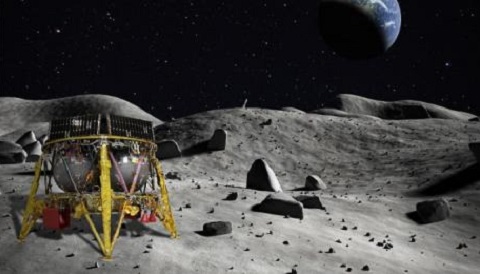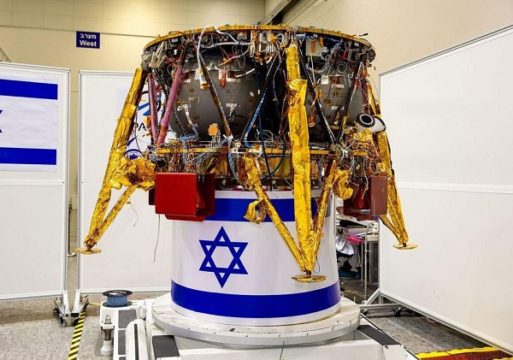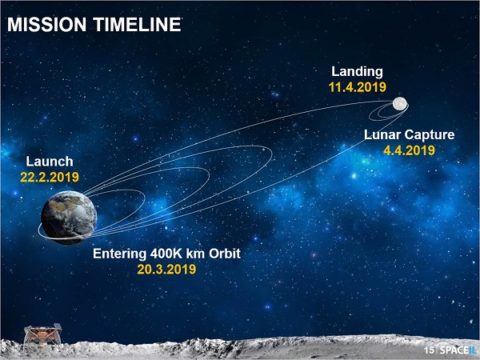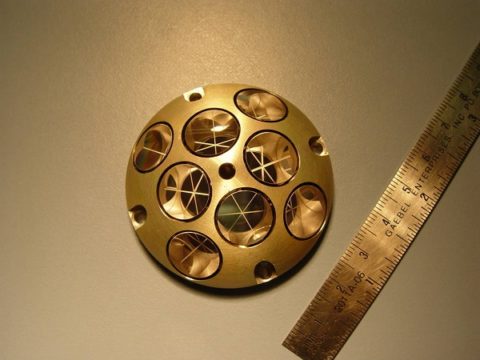Israel's Beresheet lunar lander was carried to space last night on top of a Falcon 9 rocket, headed for a soft landing on the Moon in April.

Israeli Space Agency
A SpaceX Falcon 9 rocket lit up the night skies over Florida's Space Coast on the evening of Thursday, February 21st. It carried a group of payloads into space, including the first privately funded lunar lander: the Beresheet mission from Israeli company SpaceIL. Liftoff occurred at just after 8:45 p.m. EST (1:45 UT). The Falcon 9 stage one booster that launched the missions also successfully landed on the offshore OCISLY (Of Course I Still Love You) drone ship about eight minutes after liftoff.
Originally nicknamed Sparrow, Beresheet (Hebrew for the phrase from the Book of Genesis, “in the beginning”) weighs in at 1283 pounds (582 kilograms), including about 882 pounds (400 kilograms) of propellant. The lander is 5 feet (1.5 meters) high by 6 feet (2 meters) wide. It shares the rocket's nose fairing with Indonesia's Nusantara Satu communications satellite and the U.S. Air Force Research Laboratory's S5 space situational awareness satellite. Both of the satellites are headed towards geostationary orbit.

SpaceIL
A Long Journey Ahead
The lander's trip to the launch pad was a long one, and it still has a ways to go — geostationary orbit will only get the lander a tenth of the way to the Moon. Its journey will take about seven weeks, as the lander slowly raises its orbit for capture by the Moon in early April 2019.
If successful, Israel will become the fourth nation — behind the United States, Russia, and China — to make a soft landing on the Moon. India and Japan have also fielded orbiters around the Moon. Tracking stations worldwide will now monitor Beresheet, as SpaceIL controls the mission from company headquarters in Tel Aviv. The mission team will be scouting out the 9.3-mile (15-kilometer) landing ellipse in the Mare Serenitatis (Sea of Serenity) in preparation for landing.

SpaceIL
SpaceIL and its Beresheet Lander were born from the Google Lunar XPRIZE, which challenged teams to land on the Moon, travel 500 meters on the lunar surface, and return images to Earth. Although the March 31, 2018, deadline for the $30 million award has come and gone, SpaceIL continued development. All told, the lander was a bargain at just under $100 million, funded mainly by the Israeli Space Agency and private donors.
The lander is solar-powered, with a mission slated to last 2 to 3 days before it succumbs to the heat of the lunar day. Landing is expected to occur on or around April 11th. Although the mission is primarily a technology demonstrator, it does carry a small science package equipped with an instrument to measure magnetism in Moon rocks. The spacecraft also carries a laser retroreflector, an instrument NASA contributed to help with ground tracking, and several cameras. If it survives long enough and the terrain looks like it can support it, engineers may direct Beresheet to briefly fire its engines and perform a brief “hop,” thereby satisfying the defunct Google Lunar X Prize's 500-meter travel requirement.

NASA / Goddard Space Flight Center.
Beresheet will also carry a small time capsule to the lunar surface. The first installment of the Arch Mission Foundation's 30 million-page Lunar Library will also travel to the Moon aboard Beresheet, encoded on disks the size of a U.S. dime.
Israel is no stranger to space. The country launched its first satellite, Ofeq-1, on September 19, 1988, and the Palmachim Air Base site still occasionally launches military reconnaissance satellites westward over the Mediterranean Sea. However, Beresheet represents one of the first purely scientific space missions carried out by Israel.
Target: Moon 2019
It's shaping up to be a busy year on our large natural satellite. China kicked off 2019 with Chang'e 4 and the first landing on the lunar farside on the recently christened Statio Tianhe (the ancient Chinese name for the Milky Way). If all goes well, China may carry out its ambitious Chang'e 5 lunar sample return mission by the end of 2019. India will follow suit with its Chandrayaan 2 orbiter, lander, and rover suite, slated to launch in April.
NASA has also recently announced the selection of 12 science and technology payloads to fly to the Moon as early as late 2019. Nine U.S. companies are developing smaller lunar landers under NASA Commercial Lunar Payload Services (CLPS), and the first mission task order should be out this Spring.
All this comes as we approach the 50th anniversary of the historic Apollo landing, on July 20th — an auspicious time to return to the Moon.
 2
2









Comments
Rod
February 22, 2019 at 9:34 am
Good report and thanks. The lunar lander device of Israel uses Earth's mass and gravity to pump up the apogee as it revolves around the Earth (highly elliptical orbit) and later, intercept the Moon, cool 🙂
You must be logged in to post a comment.
Warren-Odom
February 24, 2019 at 9:14 pm
Just a technical correction: The article text refers to " capture by the Moon in early May 2019," but the remainder of the article, including the Mission Timeline diagram, talks about both capture and landing in early-mid April.
You must be logged in to post a comment.
You must be logged in to post a comment.